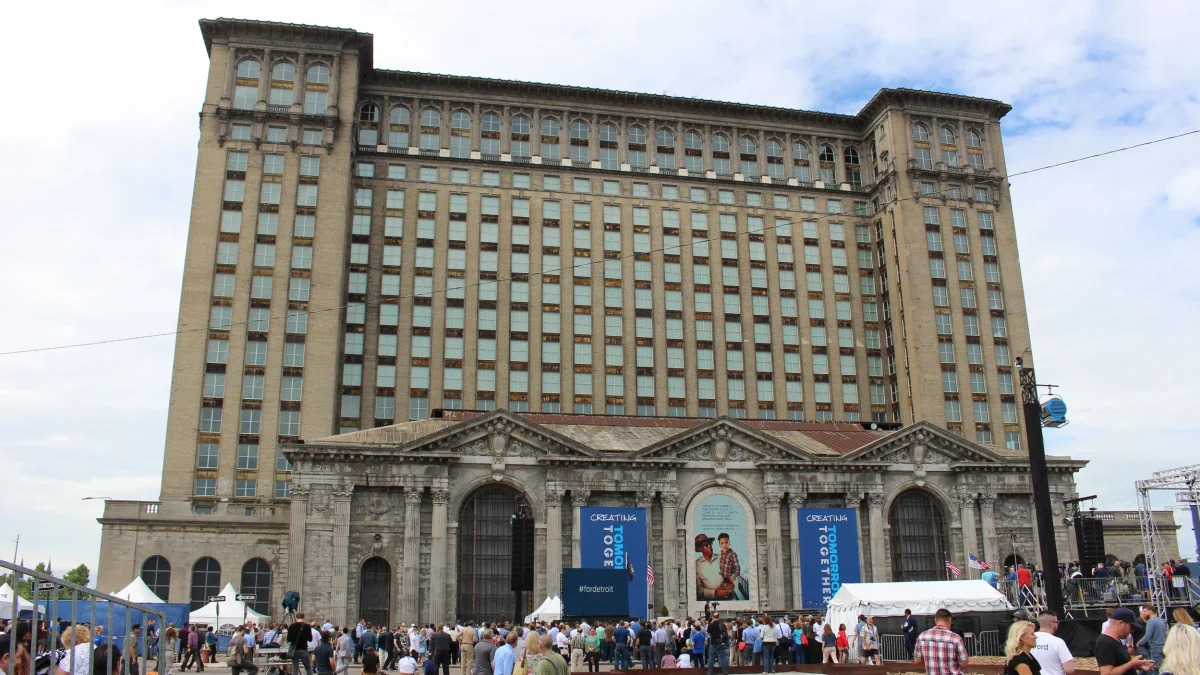Ford last week confirmed its purchase of the infamous, long-abandoned train station last week, and it released a few renderings suggesting what the place will look like when the building opens for business in 2022, if all goes well. The building will include residential units on the top two floors, plus space for other businesses and suppliers.
In a star-studded affair that included a performance from hometown rap star Big Sean, Ford Chairman Bill Ford Jr., donning black Wayfarers, a blue suit and a pink-and-blue-striped tie, discussed the historical significance of the hulking train station and how it mirrored the Motor City's meteoric rise and painful decline. His vision for the building in many ways mirrors his own environmentalist leanings: He and other company leaders see the train station anchoring a larger campus in Detroit's Corktown neighborhood where Ford will devise new mobility solutions, rethinking cities to make the air cleaner, ease traffic congestion, and build connected vehicles and roadways of the future.
At the same time, Ford says he wants the company to play an active role in helping rebuild the city where his great grandfather, Henry Ford, started the company 115 year ago. The company plans to keep the depot's soaring lobby area open to the public, filled with locally based retailers and eateries, with a renewed focus on entrepreneurship, another echo of Detroit's industrial past.
"This station is a symbol," Ford said in his prepared remarks. "But what Ford Motor Company is doing in Corktown is anything but symbolic."
Here's what Ford told Autoblog when asked about the types of jobs and functions the new building and campus will house.
"There will be a lot of mobility-related jobs, so what does that look like? There will certainly be software engineers, but there will also be people creating businesses around mobility. Think of a lot of services that will be created around that. So they will be here too. It won't be just technical people. Although there will be a number of them. There will also be business people helping to create the kind of businesses around the software and technology that is being developed. So you'll have a mix honestly."
Is that what you mean by Ford partner jobs?
"The partner jobs could be from startups because we're not going to do this all ourselves, we can't. It could be from tier ones, tier twos, from non-traditional suppliers. Really anyone who has a stake in the future and can help us build out the future. Because capital is dear, it's not unlimited, and we are very aware of that, as is everyone else in this space. So we're looking to partner wherever and with whomever we can."
Ford eventually plans to house 2,500 of its own employees, plus another 2,500 employees from suppliers and other "partners," in the train station and nearby properties. In his own prepared remarks, Ford CEO Jim Hackett invoked Silicon Valley's fabled Sand Hill Road in outlining a vision of the company's Corktown campus becoming an innovation center for mobility and the development of electric and autonomous vehicles. It would connect Detroit to the Blue Oval headquarters just down Michigan Avenue in Dearborn, the American Center for Mobility testing grounds in Willow Run, and researchers and engineers at the University of Michigan in Ann Arbor. He envisioned "an ecosystem of companies. We're gonna have partners here. Colleges are going to want to connect."
"This will play a huge role," Hackett told reporters afterward. "But we have Greenfield Labs out in Palo Alto (Calif.), that's one of the nodes, there's people there. The mobility topic crosses the physicality of the car, its engineering, which is in Dearborn. The cloud, which is in Palo Alto. The connectivity, which is both in Dearborn, Palo Alto, and here. And then the autonomous vehicle, which is in Pittsburgh. What's going to be here is a lot of the business design, of how all those things work together, is gonna be centered here."
The company won't comment on what it expects to spend to refurbish the massive train station, which is missing entire roofs in some areas and will need extensive work just to plug the many leaks that developed during 30 years of abandonment, decay, metal scrapping and vandalism. But it says the money will come from a fund already established for redeveloping its Dearborn campuses.
Whether it will work remains to be seen, and so far Wall Street appears to have reacted with a collective shrug. Ford is hardly the only company betting on mobility, and Silicon Valley itself is angling to steer transportation into the future.
But Bill Ford sees Corktown as a powerful magnet to attract talent to the organization.
"I really can't think of a better investment for our future in terms of our branding, our talent creation and also the kind of testing we're gong to have to do for our AVs than this corridor we're creating," he said.
Related Video:










Sign in to post
Please sign in to leave a comment.
Continue